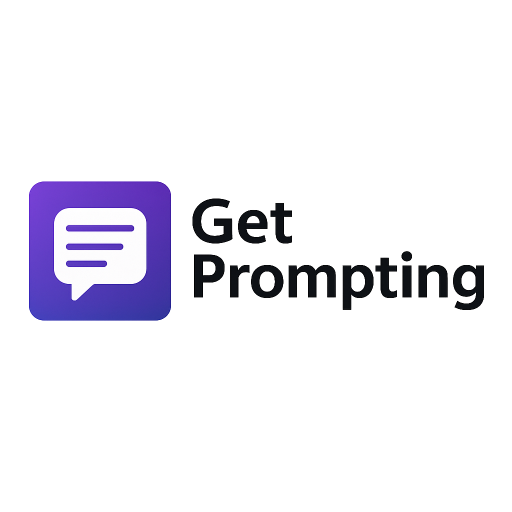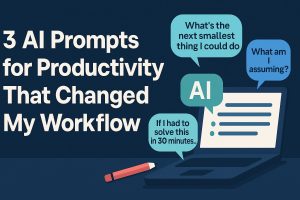The 3 AI Prompts For Productivity That Changed How I Think About My Work
I’m not gonna lie. When I first started using AI, I didn’t expect it to change much. I figured it might help me write faster or generate a few headlines when I was tired. But after using tools like ChatGPT and Claude consistently, I realized something else: it was changing how I thought, not just what I typed.
These are three AI prompts for productivity I keep coming back to. Not because they’re clever or trendy, but because they work. They’ve helped me step back, see clearer, and get unstuck when I was too deep in the weeds. If you’re looking for AI prompts for productivity that actually make a difference in real workflows, these are my personal go-to’s.
And if you’re someone juggling projects, learning to build in public, or just trying to be more intentional about your time, these might land with you too.
Prompt 1: What’s the next smallest thing I could do that would move this forward?
I picked this one up from Agile thinking (don’t worry, we’re not going full Scrum Master here). In software teams, there’s a big emphasis on slicing work down to the smallest shippable unit, the next thing you can actually finish.
This is one of my favorite AI prompts for productivity bringing that mindset into your personal workflow.
Whether I’m writing, building a new product feature, or planning a blog post, I use this to snap myself out of overthinking. It cuts through perfectionism. It reframes procrastination. And it reminds me that momentum doesn’t come from giant leaps. It comes from tiny, intentional steps.
Bonus: I use this inside my Second Brain template and now in the app I’m building. It’s a core part of how I prioritize.
Personal example: Last month, I was trying to outline a long guide on using AI for creative brainstorming. I had so many ideas that I stalled completely. I dropped this prompt into GPT, “What’s the next smallest thing I could do that would move this forward? It gave me a two-sentence summary for the intro. That was it. But that cracked the door. The next day I wrote the first 500 words.
Sometimes we need permission to start small.
Prompt 2: What am I assuming that might not be true?
This one hit me during a stuck moment while writing.
I’d been spinning my wheels trying to get something to land, and nothing felt right. I tossed this prompt into Claude as a kind of “help me debug my brain” moment. What came back was a list of assumptions I hadn’t even noticed I was making, about tone, audience, even why I was writing the piece in the first place.
Now I use it regularly when I feel tension or resistance in a task. Especially if something feels bigger or more annoying than it should be.
It’s a thinking prompt. A pattern interrupt. And yeah, Agile folks will recognize it as a retro question in disguise, but you don’t have to be on a team to benefit from better self-reflection.
Personal example: While writing the outline for the AI workshop I am teaching at work, I realized I was assuming everyone using ChatGPT already knew what “temperature” or “tokens” meant. I was skipping explanations. But after running this prompt, I realized my assumptions were off. I was writing for myself, not my audience. That tweak alone made the next draft so much better.
Sometimes the problem isn’t the project. It’s the mental filter you’re using to see it.
Prompt 3: If I had to solve this in 30 minutes with no perfect solution, what would I do?
Deadlines don’t scare me as much as possibility paralysis.
This prompt came from a moment where I had too many options, too much time, and not enough urgency. Giving myself fake constraints with AI changed how I made decisions.
Sometimes I run this through GPT and just ask it to simulate what a scrappy solution would look like. Other times, I write it out myself.
It doesn’t give me “the best plan.” It gives me a starting point. And most of the time, that’s all I need to get going.
Personal example: When I first started thinking about building the desktop app version of my Second Brain, I was overwhelmed. So many features, so many ways to go. I dropped this exact prompt into Claude and got back a plan that wasn’t perfect, but it was doable. It broke the paralysis. Within a few days, I had the entire Tauri + React skeleton built and running locally.
This prompt is now a default tool in my belt whenever I feel stuck in perfectionism.
Why These AI Prompts for Productivity Matter (And Why I’m Sharing Them)
These prompts aren’t magic. They’re not meant to replace thinking. But they do help me frame problems faster, get out of my own head, and keep moving.
That’s what Agile is really about, underneath all the jargon: small wins, clarity, and forward motion.
And honestly? That’s how I’m trying to build everything now. From my blog to my product to the way I use my time.
Whether you’re running a team or just trying to get your side hustle off the ground, these kinds of mental shortcuts matter. We don’t always need more time or more effort. Sometimes, we just need the right question.
If you’re looking for real-world examples of AI prompts for productivity, this is where I’d start. These aren’t just theory, they’re the same ones I’ve used to plan projects, fix stuck writing, and launch tools faster than I would have solo.
If any of these prompts help you this week, let me know. Or grab my free AI Prompting starter pack and see how I structure my workflow around prompts like these.
Because the right prompt at the right time? That’s more powerful than another to-do list.
Michael, Creator of Get Prompting

